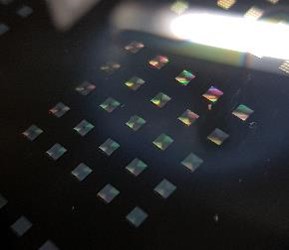The technology of micro- or nanostructuring enables the implementation of novel optical components such as metasurfaces and metalenses. Metasurfaces are structured two-dimensional surfaces composed of regularly arranged nanostructures. The unique aspect of these nanostructures is their dimension, which is several times smaller than the wavelength of the light they interact with, thereby enabling the manipulation of light propagation at the sub-wavelength level. Based on this, novel optical components can be constructed, including so-called metalenses.
Metalenses are special structures of metasurfaces and enable the realization of planar optical lenses, which are distinguished from conventional diffractive lenses by their reduced height. Through nanostructuring (alignment, shape, size) and their periodic arrangement, a specific phase profile is implemented, where the individual nanostructures implement a specific transmission amplitude and phase. This allows for targeted and wavelength-specific modeling of optical properties (focal length, numerical aperture) of the metalens.
Besides metalenses, further optical components can be implemented using metasurfaces and accordingly miniaturized. These include coupling and decoupling structures, beam splitters, polarizers, and reflectors.
Through the application of microtechnology manufacturing processes, metaoptics can not only be mass-produced cost-effectively at the wafer level but also offer the potential to integrate microoptics into conventional chip technologies through appropriate process steps. The latter enables novel devices in which both electrical and optical functions are integrated.
Potential applications for integrated microoptics are seen in quantum technologies and in PICs, where both optical and electronic integrated circuits are needed on a chip. The application of highly integrated and miniaturized optical metasurfaces could represent a key component, which is why Fraunhofer ENAS, in close cooperation with Chemnitz University of Technology, is researching integrable microoptics based on metasurfaces.
 Fraunhofer Institute for Electronic Nano Systems
Fraunhofer Institute for Electronic Nano Systems

